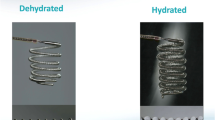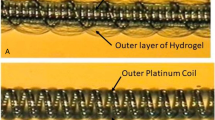Abstract
Introduction
Hybrid hydrogel-platinum coils (HydroCoil) have proven effective for endovascular aneurysm treatment. To overcome technical limitations (coil stiffness, time restriction for placement), a second generation of softer hydrogel coils has been brought to clinical practice (HydroSoft, HydroFrame). We report on procedural safety and core-lab-assessed angiographic results from an open-label multicenter randomized controlled trial.
Methods
Web-based randomization occurred in 15 medical centers in France and seven in Germany between coil embolization with second-generation hydrogel coils and treatment with any bare platinum coil. Assist devices could be used as clinically required. Primary endpoint is a composite outcome including major aneurysm recurrence and poor clinical outcome at 18 months follow-up.
Results
Five hundred thirteen patients were randomized (hydrogel n = 256, bare platinum n = 257). Twenty patients were excluded for missing informed consent and nine patients for treatment related criteria. Four hundred eighty-four patients were analyzed as randomized (hydrogel n = 243, bare platinum n = 241). Two hundred eight had ruptured aneurysms (43 %). Prespecified procedural complications occurred in 58 subjects (hydrogel n = 28, bare platinum n = 30, p = 0.77). The 14-day mortality rate was 2.1 % in both arms of the study. The median calculated packing densities for aneurysms assigned to hydrogel and bare platinum were 39 and 31 % respectively (p < 0.001). No statistically significant differences were found between arms in the post procedural angiographic occlusion rate (p = 0.8).
Conclusion
Second-generation hydrogel coils can be used in a wide spectrum of aneurysms with a risk profile equivalent to bare platinum. Packing density was significantly higher in aneurysms treated with hydrogel coils.
Trial registration
http://www.germanctr.de, DRKS00003132

Similar content being viewed by others
References
Molyneux A, Kerr R, Stratton I et al (2002) International Subarachnoid Aneurysm Trial (ISAT) Collaborative Group. International Subarachnoid Aneurysm Trial (ISAT) of neurosurgical clipping versus endovascular coiling in 2143 patients with ruptured intracranial aneurysms: a randomised trial. Lancet 360:1267–1274
Taschner CA, Leclerc X, Gauvrit JY et al (2007) Safety of endovascular treatment of intracranial aneurysms with a new, complex shaped Guglielmi detachable coil. Neuroradiology 49:761–766
Slob MJ, Sluzewski M, van Rooij WJ et al (2005) The relation between packing and reopening in coiled intracranial aneurysms: a prospective study. Neuroradiology 47:942–945
Molyneux AJ, Clarke A, Sneade M et al (2012) Cerecyte coil trial: angiographic outcomes of a prospective randomized trial comparing endovascular coiling of cerebral aneurysms with either cerecyte or bare platinum coils. Stroke 43:2544–2550
McDougall CG, Johnston SC, Gholkar A (2014) Bioactive versus bare platinum coils in the treatment of intracranial aneurysms: the MAPS (Matrix and Platinum Science) trial. AJNR Am J Neuroradiol 35:935–942
White PM, Lewis SC, Gholkar A et al (2011) Hydrogel-coated coils versus bare platinum coils for the endovascular treatment of intracranial aneurysms (HELPS): a randomised controlled trial. Lancet 377:1655–1662
Tsumoto T, Niimi Y, Berenstein A (2009) Evaluation of the new HydroSoft coil in a canine model of bifurcation aneurysm. Lab Investig J Neurosurg 111:11–16
Killer M, Kallmes D, Jones R et al (2010) Long-term angiographic and histological results of a new hydrogel-containing filling coil in experimental rabbit aneurysms. Minim Invasive Neurosurg 53:97–105
Guo XB, Fan YM, Zhang JN (2011) HydroSoft coil versus HydroCoil for endovascular aneurysm occlusion study: a single center experience. Eur J Radiol 79:e42–e46
Waldau B, Turk AS 3rd, Yashar P et al (2012) Perioperative safety of HydroSoft coils. J Neurointerv Surg 4:375–378
Park JH, Kang HS, Han MH et al (2011) Embolization of intracranial aneurysms with HydroSoft coils: results of the Korean multicenter study. AJNR Am J Neuroradiol 32:1756–1761
Lee JY, Seo JH, Lee SJ et al (2014) Mid-term outcome of intracranial aneurysms treated with HydroSoft coils compared to historical controls treated with bare platinum coils: a single-center experience. Acta Neurochir 156:1687–1694
Taschner C, Chapot R, Costalat V et al (2015) GREAT-a randomized aneurysm trial. Design of a randomized controlled multicenter study comparing HydroSoft/HydroFrame and bare platinum coils for endovascular aneurysm treatment. Neuroradiology 57:599–604
Roy D, Milot G, Raymond J (2001) Endovascular treatment of unruptured aneurysms. Stroke 32:1998–2004
Yan X, Su XG (2010) Stratified Wilson and Newcombe confidence intervals for multiple binomial proportions. Stat Biopharm Res 2(3):329–335
van Elteren PH (1960) On the combination of independent two-sample tests of Wilcoxon. Bull Int Stat Inst 37:351–361
Pierot L, Spelle L, Vitry F (2008) Immediate clinical outcome of patients harboring unruptured intracranial aneurysms treated by endovascular approach: results of the ATENA study. Stroke 39:2497–2504
Pierot L, Cognard C, Ricolfi F et al (2010) Immediate anatomic results after the endovascular treatment of ruptured intracranial aneurysms: analysis in the CLARITY series. AJNR Am J Neuroradiol 31:907–911
Acknowledgments
The study was funded by MicroVention Inc., the manufacturers of the HydroSoft/HydroFrame coils. MicroVention Inc. supplied the electronic case report form for data entry. We would also like to thank the following: Core Lab: Hubert Desal and Jens Fiehler. Trial Steering Committee: Christian Taschner (Lead Investigator), Alain Bonafé (Co-ordinator: French Centres), Martin Schumacher, Matthias Reinhard and Vera van Velthoven. Data Monitoring and Safety Committee: Daniel Rüfenacht (Chair), Werner Hacke and Meinhard Kieser (Statistician).
Author information
Authors and Affiliations
Corresponding author
Ethics declarations
We declare that all human studies have been approved by the leading ethics committee (Faculty of Medicine, Freiburg University, Freiburg, Germany [077/09]) and the local ethics committees and were authorized by the competent French and German authorities and have therefore been performed in accordance with the ethical standards laid down in the 1964 Declaration of Helsinki and its later amendments. We declare that all patients gave informed consent prior to inclusion in this study.
Conflict of interest
CAT has consulted for MicroVention Inc, Stryker Neurovascular, and Acandis GmbH.
Additional information
GREAT investigators
France
C Barbier. Department of Neuroradiology, CHU Caen, Caen
Jean Gabrillargues, Emanuel Chabert, A Fischer. Department of Neuroradiologie, Hôpital Gabriel-Montpied, CHU Clermont-Ferrand, Clermont-Ferrand
Frédéric Ricolfi. Department of Neuroradiology, CHU Dijon, Dijon
Charbel Mounayer. Department of Neuroradiology, CHU Limoges, Limoges
Marinette Moynier. Department of Neuroradiology, CHU Montpellier, Montpellier
Michel Piotin, Bruno Bartolini. Department of Interventional Neuroradiology, Fondation Rothschild Hospital, Paris
Nader Sourour. Department of Neuroradiology, Hôpital Salpétrière, AP-HP, Paris
Jean-Yves Gauvrit. Department of Neuroradiology, CHU Rennes, Rennes
Eléonore Tollard. Department of Neuroradiology, CHU Rouen, Rouen
C Papgiannaki, Richard Bibi. Department of Neuroradiology, CHU Tours, Tours
Germany
Paul Stracke. Department of Intracranial Endovascular Therapy, Alfried-Krupp Krankenhaus Hospital, Essen
Marc Schlamann, Sophia Göricke, Claudia Möller-Hartmann, Isabell Wanke. Department of Diagnostic and Interventional Radiology and Neuroradiology, University Hospital Essen, Essen
Richard du Mesnil de Rochemont. Institute of Neuroradiology, University Hospital Frankfurt, Frankfurt am Main
Stephan Meckel, Ulrike Bergmann. Department of Neuroradiology, Medical Centre-University of Freiburg, Freiburg
Elke Gizewski, Thorsten Schmidt. Department of Neuroradiology, University Hospital Giessen, Giessen
Christoph Groden. Department of Neuroradiology, Universitätsmedizin Mannheim, University of Heidelberg, Mannheim
Rights and permissions
About this article
Cite this article
Taschner, C.A., Chapot, R., Costalat, V. et al. GREAT—a randomized controlled trial comparing HydroSoft/HydroFrame and bare platinum coils for endovascular aneurysm treatment: procedural safety and core-lab-assessedangiographic results. Neuroradiology 58, 777–786 (2016). https://doi.org/10.1007/s00234-016-1693-y
Received:
Accepted:
Published:
Issue Date:
DOI: https://doi.org/10.1007/s00234-016-1693-y




